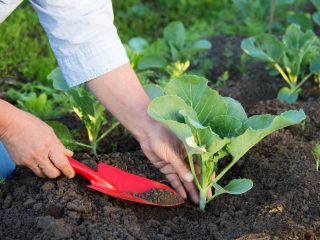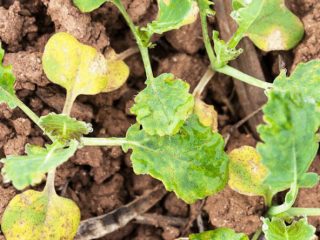Content
Snow White cabbage is a universal white cabbage variety. The variety is distinguished by its late ripening period and also has many advantages that attract vegetable growers.
Description of cabbage variety Snow White
Cabbage of the Snow White variety (pictured) forms a small head of cabbage, which is formed by large light green or bluish-green leaves with a diameter of up to 16 cm. Distinctive features are: a medium-wrinkled surface, slight venation and smooth or slightly wavy edges. The heads of cabbage are dense and shiny; the stalk is small, round. The pulp is white when cut.

Snow White has a medium-sized rosette, the lower leaves are slightly lowered or raised
The period from the emergence of seedlings to the harvesting of heads of cabbage is 4-5 months, that is, when sowing seedlings in April, the first harvest can be obtained in early September.
The Snow White variety is highly frost-resistant, so the crop can easily tolerate frosts down to -10 °C. This significantly extends the harvest time.
Advantages and disadvantages
The Snow White variety is valued for the following qualities:
- excellent seed germination;
- great taste;
- increased resistance of heads of cabbage to cracking;
- large fruit sizes;
- frost resistance, allowing harvesting in late autumn;
- high content of ascorbic acid, sugars and other dry substances;
- versatility of application;
- high (up to 8 months) shelf life.
Disadvantages include average immunity to diseases and pests. Some gardeners consider the late ripening of heads of cabbage to be a disadvantage, but most of those who grow this crop choose the Snow White variety precisely because of its late ripening and long storage period.
Productivity of white cabbage Snow White
Like other late-ripening varieties, Snow White has a high yield. From 1 sq. m harvest 5 - 8, and with good care, 10 kg of cabbage. The average fruit weight is 4 kg, especially large specimens weigh up to 5 kg.
Planting and caring for Snow White cabbage
Before planting Snow White cabbage in the garden, be sure to drive out the seedlings. The containers are filled with a light soil mixture, into which pre-soaked and disinfected seeds are sown to a depth of 2 cm. You can use common boxes, but it is better to immediately sow the seeds in individual (peat) pots.
The soil with the seeds is well watered, the containers are covered with film, which is removed when the first shoots appear. Then the temperature in the room is maintained at 8-10 °C, and with the appearance of the first true leaves, it is increased to 14-16 °C. If seedlings are driven out in common boxes, they are picked at the stage of two true leaves.
After 1.5-2 months, when the seedlings get stronger and warm weather sets in, Snow White cabbage is planted in the garden.
The landing site is chosen high, well lit and protected from the wind. Loams are suitable as a substrate. In the fall, the site is dug up, and on the eve of planting, a soil mixture is prepared from equal parts of garden soil and humus with the addition of a small amount of ash.
The best precursors for cabbage are potatoes, cucumbers and legumes. It is highly undesirable to plant cabbage after cruciferous crops, since the plantings can be infected with common diseases and pests.
When planting, seedlings are buried approximately 10 cm.

Snow White cabbage is grown according to the 50x60 cm pattern
In the future, the main task will be regular watering of the plantings. During the period of active growth, cabbage is watered about every other day; closer to autumn, the frequency of watering is reduced to twice a week, but the water consumption for each plant is increased by about 1.5 times.
To prevent the soil from forming a crust after watering, the soil around the plants is loosened. At the same time, weeds are removed and hilling is performed. In the active growth phase, the procedure is carried out once a week, when the head is forming - 2 times a month. It is very important not to damage the root system, so all manipulations are carried out only in the surface layer of soil (no deeper than 10 cm).
Fertilizing has a positive effect on crop growth and can significantly increase productivity. In the first half of the growing season, plants are fertilized with organic compounds (chicken droppings, urea, manure, ammonium nitrate), and when heads are formed - with fertilizing that does not contain nitrogen, for example, ash or nitrophosphate.

Snow White cabbage requires careful care in a timely manner
Diseases and pests
Cabbage variety Snow White has increased immunity against vascular bacteriosis and Fusarium wilt, but can be affected by other diseases. Clubroot, blackleg and downy mildew are dangerous. At the first signs of disease, you should remove the affected plants and treat the beds with a solution of copper sulfate.
Of the insects, Snow White cabbage is most often affected by cruciferous bugs, aphids, cabbage whites and stem secrecy. Traditional methods can be an effective alternative to insecticides in the fight against them: spraying plants with an aqueous solution of liquid soap or treating them with tobacco dust.
Application
Although Snow White cabbage is considered a universal variety, many housewives do not recommend consuming it raw due to the hardness of the leaves. But it is perfect for pickling and pickling. Snow White cabbage can be used to prepare soups, vegetable side dishes, cabbage rolls, pie fillings and other cooked dishes.
Conclusion
Snow White cabbage is perfect for growing in areas with long summers - in the south and central Russia. Like other varieties of this crop, Snow White needs careful care, which guarantees an excellent harvest.








